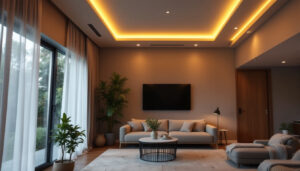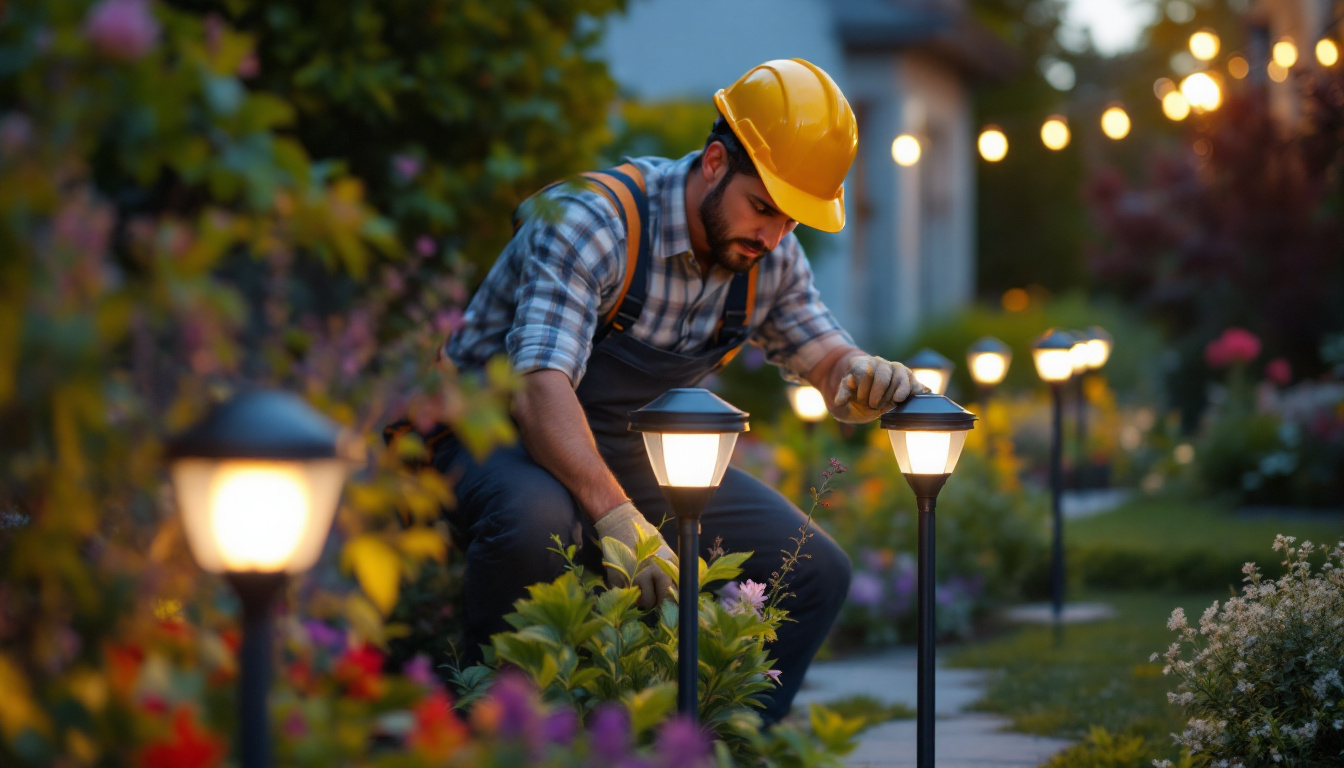

As the demand for outdoor lighting solutions continues to grow, lighting contractors must stay informed about the latest trends, technologies, and best practices in the industry. This article provides essential tips for lighting contractors focusing on exterior light fixtures, ensuring that projects are not only aesthetically pleasing but also functional and energy-efficient.
Exterior lighting encompasses a variety of fixtures designed to illuminate outdoor spaces. Common types include wall sconces, floodlights, path lights, and post lights. Each type serves a specific purpose, whether it’s enhancing security, highlighting architectural features, or providing ambient lighting for outdoor gatherings. For instance, wall sconces can create a warm and inviting atmosphere on porches or patios, while floodlights are perfect for illuminating large areas such as driveways or backyards, ensuring safety and visibility during nighttime hours.
When selecting fixtures, consider the environment in which they will be installed. Coastal areas may require corrosion-resistant materials, while rural settings might benefit from fixtures that blend seamlessly with natural surroundings. Moreover, energy efficiency is another critical factor; opting for LED fixtures not only reduces energy consumption but also extends the lifespan of the lighting. Understanding the unique requirements of each project is crucial for delivering optimal results, as it allows homeowners to create a cohesive look that enhances both functionality and aesthetic appeal.
Proper installation is vital for the longevity and effectiveness of exterior light fixtures. Contractors should ensure that all fixtures are rated for outdoor use and installed at the correct height and angle for maximum illumination. Additionally, wiring should be protected from moisture and other environmental factors. It’s essential to use weatherproof connectors and junction boxes, as these components will safeguard the electrical connections from rain and humidity, thus preventing potential hazards.
It’s also important to consider the layout of the lighting design. A well-planned arrangement not only enhances the aesthetic appeal but also ensures safety by eliminating dark spots. Contractors should take the time to map out the placement of fixtures before installation begins. This planning phase can involve using tools like lighting design software or even simple sketches to visualize how the light will interact with the surrounding landscape. Furthermore, incorporating smart lighting solutions can add versatility, allowing homeowners to control their outdoor lighting remotely or set schedules for automatic operation, enhancing both convenience and security.
With growing concerns about energy consumption and environmental impact, selecting energy-efficient light fixtures is more important than ever. LED fixtures are a popular choice for outdoor lighting due to their longevity and low energy consumption. They can last up to 25 times longer than traditional incandescent bulbs, significantly reducing replacement costs and waste. Additionally, LEDs emit less heat, which can help maintain a cooler environment in outdoor spaces, making them ideal for areas that experience high temperatures.
In addition to LEDs, consider fixtures that incorporate solar technology. Solar-powered lights harness sunlight during the day and provide illumination at night without relying on the electrical grid. This not only reduces energy costs but also appeals to environmentally conscious clients. Furthermore, advancements in solar technology have led to more efficient panels and brighter LED lights, making solar options more viable than ever. Many modern solar fixtures come with built-in sensors that automatically turn on at dusk and off at dawn, ensuring that energy is used only when needed, thereby maximizing efficiency.
The rise of smart home technology has extended to outdoor lighting as well. Smart lighting systems allow homeowners to control their exterior lights remotely, set schedules, and adjust brightness levels. For contractors, offering smart lighting solutions can enhance the value of a project and attract tech-savvy clients. These systems can also integrate with security features, providing an added layer of safety by allowing homeowners to simulate occupancy when they are away, which can deter potential intruders.
When integrating smart technology, ensure that the chosen fixtures are compatible with popular smart home platforms. This compatibility will not only streamline installation but also provide clients with a seamless experience when managing their outdoor lighting. Additionally, many smart lighting solutions now offer energy monitoring capabilities, allowing homeowners to track their energy usage in real-time. This data can empower clients to make informed decisions about their energy consumption, further promoting sustainability and energy efficiency in their homes.
Exterior lighting should complement the overall design of the property. When selecting fixtures, consider the architectural style of the home and the surrounding landscape. For instance, modern homes may benefit from sleek, minimalist fixtures, while traditional homes might look best with ornate designs. The choice of materials for the fixtures is equally important; metals like brass or copper can add a touch of elegance, while durable plastics or powder-coated finishes may offer a more contemporary or industrial vibe. Additionally, integrating lighting with landscaping elements, such as using fixtures that mirror the colors and textures of nearby plants, can create a seamless transition between the built environment and nature.
Color temperature is another critical aspect of design. Warm white light (2700K-3000K) creates a cozy atmosphere, while cooler temperatures (4000K-5000K) can provide a more contemporary feel. By carefully selecting the color temperature and style of fixtures, contractors can help clients achieve a harmonious outdoor space. Furthermore, the layering of light—incorporating ambient, task, and accent lighting—can enhance the usability of outdoor areas while also establishing a mood. For example, soft ambient lighting can invite relaxation, while brighter task lighting can facilitate outdoor cooking or dining experiences, ensuring that every moment spent outside is both functional and enjoyable.
Exterior lighting can be used strategically to highlight key architectural features or landscaping elements. For example, uplighting can be employed to illuminate trees, while downlighting can enhance pathways and patios. By using a combination of different lighting techniques, contractors can create depth and interest in outdoor spaces. This not only enhances the aesthetic appeal but also improves safety by illuminating potential hazards, such as steps or uneven surfaces. Moreover, the use of smart lighting technology allows homeowners to adjust the brightness and color of their outdoor lights, enabling them to set the perfect ambiance for different occasions, from lively gatherings to quiet evenings.
It’s also essential to consider the direction of light. Lighting from below can create dramatic shadows, while lighting from above can provide a softer, more diffused effect. Understanding how to manipulate light can significantly enhance the overall aesthetic of a project. Additionally, incorporating features like motion sensors or timers can add convenience and security, ensuring that lights activate when needed and conserve energy when not in use. By thoughtfully designing the placement and function of exterior lighting, contractors can not only elevate the beauty of a property but also create a welcoming environment that encourages outdoor living year-round.
Lighting contractors must be aware of local codes and regulations regarding outdoor lighting. These regulations often dictate the types of fixtures that can be used, their placement, and their brightness levels. Failure to comply can lead to fines and project delays, making it essential for contractors to stay informed about local requirements.
In addition to legal compliance, safety should always be a priority. Fixtures should be installed in a way that minimizes hazards, such as tripping or glare. Conducting a thorough safety assessment before installation can help identify potential issues and ensure a safe environment for both workers and homeowners.
Electrical safety is paramount when working with exterior lighting. Contractors should ensure that all wiring is properly rated for outdoor use and that connections are secure and weatherproof. Using GFCI (Ground Fault Circuit Interrupter) outlets is also recommended to prevent electrical shocks.
Regular maintenance checks are essential to ensure that all fixtures remain in good working order. This includes inspecting for damaged wiring, corroded fixtures, and burnt-out bulbs. By prioritizing electrical safety, contractors can protect themselves, their clients, and the integrity of the lighting system.
Once the installation is complete, contractors should provide clients with clear maintenance guidelines. This includes information on cleaning fixtures, replacing bulbs, and checking for any signs of wear and tear. Regular maintenance not only prolongs the life of the fixtures but also ensures that they continue to perform effectively.
Encouraging clients to schedule seasonal maintenance checks can help identify potential issues before they become significant problems. This proactive approach can save clients money in the long run and enhance their satisfaction with the lighting system.
If smart lighting solutions have been installed, it’s crucial to educate clients on how to use these features effectively. Providing a demonstration on how to control the lights via a smartphone app or voice command can enhance the user experience and ensure that clients feel confident in managing their new system.
Additionally, offering ongoing support for smart lighting systems can help build trust and encourage clients to reach out with any questions or concerns. This level of customer service can set a contractor apart in a competitive market.
Exterior lighting is a vital aspect of any landscaping or architectural project, and lighting contractors play a crucial role in its design and installation. By understanding the various types of fixtures, prioritizing energy efficiency, and adhering to safety regulations, contractors can deliver exceptional results that meet the needs of their clients.
Moreover, by focusing on design considerations, maintenance, and customer education, contractors can create lasting relationships with their clients, ensuring satisfaction long after the installation is complete. As the industry continues to evolve, staying informed about the latest trends and technologies will be key to success in the field of exterior lighting.
Ready to elevate your lighting projects with superior quality and value? Look no further than LumenWholesale for all your exterior lighting needs. We provide lighting contractors with an extensive selection of spec-grade lighting products at wholesale prices that simply can’t be beaten. Say goodbye to middleman markups and hello to reliability and high performance for every project. With free shipping on bulk orders, LumenWholesale is your go-to source for premium lighting solutions that blend quality, affordability, and convenience seamlessly. Don’t compromise on your lighting—choose LumenWholesale and give your clients the brilliance they deserve. Discover our unbeatable deals and Wholesale Lighting at the Best Value today.

Discover the essential insights every lighting contractor needs to know about ceiling lights.

Discover expert tips and strategies for lighting contractors to enhance outdoor spaces with top solar lights.

Discover why purchasing recessed lighting in bulk from local distributors might not be the best decision.

Discover essential strategies to sidestep common pitfalls in lighting projects with our comprehensive guide on light manufacturing.
Get notified when NEW deals are released.
Optimize your budget with wholesale discounts.
Only top-quality, specification-grade lighting products.
No additional costs at checkout - what you see is what you pay.
We understand the unique needs of contractors.